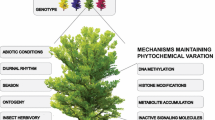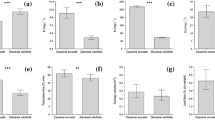Abstract
Between-tree variation in the terpenoid composition in the foliage of six species of Eucalyptus was investigated in relation to its effects on herbivory by Christmas beetles (Anoplognathus spp.). All six eucalypt species showed considerable intraspecific variation in terpenoid composition; the cineole content ranged from 13% to 78% of the total oil in different E. melliodora trees, from 0% to 67% in E. conica, 3% to 79% in E. sideroxylon, 1% to 76% in E. camaldulensis, 3% to 60% in E. rubida and 20% to 79% in E. blakelyi. Levels of defoliation by Christmas beetles of nine E. melliodora and eight E. conica trees were quantified from frass traps placed under each tree, and were used to confirm the reliability of visual ratings of defoliation. Defoliation was assessed visually for all six species and was found to be unrelated to the total amount of terpenoids in the foliage of each tree, but strongly associated with the percentage of cineole in the terpenoid mixture. Levels of most terpenoid components were significantly inter-correlated, so it was not possible to determine which components directly affected defoliation. The dominant Christmas beetle at all sites was A. montanus.
Similar content being viewed by others
References
Baker RT, Smith HG (1920) A research on the eucalypts, especially in regard to their essential oils. Government Printer, Sydney
Brooker MIH, Lassak EV (1981) The volatile leaf oils of Eucalyptus ovata Labill. and E brookerana A.M. Gray (Myrtaceae). Aust J Bot 29:605–615
Carne PB (1957) A revision of the ruteline genus Anoplognathus Leach (Coleoptera: Scarabaeidae). Aust J Zool 5:88–143
Carne PB (1965) Distribution of the eucalypt-defoliating sawfly Perga affinis affinis (Hymenoptera). Aust J Zool 13:593–612
Carne PB (1966) Ecological characteristics of the eucalypt-defoliating chrysomelid Paropsis atomaria 01. Aust J Zool 14:647–672
Carne PB, Greaves RTG, McInnes RS (1974) Insect damage to plantation-grown eucalypts in north coastal New South Wales, with particular reference to Christmas beetles (Coleoptera: Scarabaeidae). J Aust Entomol Soc 13:189–206
Cates RG (1975) The interface between slugs and wild ginger: some evolutionary aspects. Ecology 56:391–400
Cates RG, Redak RA (1988) Variation in the terpene chemistry of Douglas-fir and its relationship to western spruce budworm success. In: Spencer KC (ed) Chemical mediation of coevolution. Academic Press, San Diego, pp 317–344
Clark LR (1962) The general biology of Cardiaspina albitextura (Psyllidae) and its abundance in relation to weather and parasitism. Aust J Zool 10:537–586
Doran JC (1991) Commercial sources, uses, formation, and biology. In: Boland DJ, Brophy JJ, House APN (eds) Eucalyptus leaf oils — use, chemistry, distillation and marketing. Inkata Press, Melbourne, pp 11–25
Edwards PB, Wanjura WJ, Brown WV, Dearn JM (1990) Mosaic resistance in plants. Nature 347:434
Gouyon PH, Fort Ph, Caraux G (1983) Selection of seedlings of Thymus vulgarus by grazing slugs. J Ecol 71:299–306
Hillis WE, Isoi K (1965) Variation in the chemical composition of Eucalyptus sideroxylon. Phytochemistry 4:541–550
Journet ARP (1980) Intraspecific variation in food plant favourability to phytophagous insects: psyllids on Eucalyptus blakelyi M. Ecol Entomol 5:249–261
Langenheim JH, Foster CE, McGinley RB (1980) Inhibitory effects of different quantitative compositions of Hymenaea leaf resins on a generalist herbivore Spodoptera exigua. Biochem Syst Ecol 8:385–396
Langenheim JH, Corvis CL, Macedo CA, Stubblebine WH (1986) Hymenaea and Copaifera leaf sesquiterpenes in relation to lepidopteran herbivory in southeastern Brazil. Biochem Syst Ecol 14:41–49
Mazanec Z (1985) Resistance of Eucalyptus marginata to Perthida glyphopa (Lepidoptera: Incurvariidae). J Aust Entomol Soc 24:209–221
McKern HHG (1965) Volatile oils and plant taxonomy. J Proc R Soc New South Wales 98:1–10
Morrow PA, Fox LR (1980) Effects of variation in Eucalyptus essential oil yield on insect growth and grazing damage. Oecologia 45:209–219
Morrow PA, Bellas TE, Eisner T (1976) Eucalyptus oils in the defensive oral discharge of Australian sawfly larvae (Hymenoptera: Pergidae). Oecologia 24:193–206
Ohmart CP, Edwards PB (1991) Insect herbivory in Eucalyptus. Annu Rev Entomol 36:637–657
Ohmart CP, Larsson S (1989) Evidence for absorption of eucalypt essential oils by Paropsis atomaria Olivier (Coleoptera: Chrysomelidae). J Aust Entomol Soc 28:201–205
Penfold AR, Morrison FR (1927) The occurrence of a number of varieties of Eucalyptus dives as determined by chemical analyses of the essential oils. Part I. J Proc R Soc New South Wales 61:54–67
Penfold AR, Morrison FR (1933) The essential oils of Eucalyptus micrantha (De Candolle), including a form rich in piperitone. Part II. J Proc R Soc New South Wales 67:351–363
Penfold AR, Morrison FR, McKern HHG (1948a) Studies in the physiological forms of the Myrtaceae. Part I Leptospermum citratum Challinor, Cheel and Penfold and its physiological forms. Res Essent Oils Aust Flora 1:12–17
Penfold AR, Morrison FR, McKern HHG (1948b) Studies in the physiological forms of the Myrtaceae. Part II The occurrence of physiological forms in Melaleuca alternifolia Cheel. Res Essent Oils Aust Flora 1:18–19
Penfold AR, Morrison FR, McKern HHG, Willis J (1950) Studies in the physiological forms of the Myrtaceae. Part V Eucalyptus citriodora Hook. and the incidence of its physiological forms. Res Essent Oils Aust Flora 2:12–14
Pryor LD (1953) Variable resistance to leaf-eating insects in some eucalypts. Proc Linn Soc New South Wales 77:364–368
Pryor LD, Bryant LH (1958) Inheritance of oil characteristics in Eucalyptus. Proc Linn Soc New South Wales 83:55–64
Rhoades DF (1979) Evolution of plant chemical defense against herbivores. In Rosenthal GA, Janzen DJ (eds) Herbivores their interaction with secondary plant metabolites. Academic Press, New York, pp 3–54
Rice RL, Lincoln DE, Langenheim JH (1978) Palatibility of monoterpenoid compositional types of Satureja douglasii to a generalist molluscan herbivore, Ariolimax dolichophallus Biochem Syst Ecol 6:45–53
Salasoo I (1985) Rimuene in Epacridaceae and Ericaceae: existence of chemotypes? Aust J Bot 33:239–243
Schultz JC (1983) Impact of variable plant defensive chemistry on susceptibility of insects to natural enemies. In: Hedin PA (ed) Plant resistance to insects (ACS Symposium Series 208). American Chemical Society, Washington, pp 37–54
Sturgeon KB (1979) Monoterpene variation in ponderosa pine xylem resin related to western pine beetle predation. Evolution 33:803–814
Wallace MMH (1970) The biology of the jarah leaf miner, Perthida glyphopa Common (Lepidoptera: Incurvariidae). Aust J Zool 18:91–104
Whiffin T (1982) Variation and evolution in the genus Flindersia (Rutaceae). II Review of methods for geographic variation analysis of volatile oil data. Aust J Bot 30:645–657
Wilcox MD (1982) Anthocyanin polymorphism in seedlings of Eucalyptus fastigata Deane & Maid. Aust J Bot 30:501–509
Willis JL, McKern HHG, Hellyer RO (1963) The volatile oils of the genus Eucalyptus (fam. Myrtaceae). I. Factors affecting the problem. J Proc R Soc New South Wales 96:59–64
Author information
Authors and Affiliations
Rights and permissions
About this article
Cite this article
Edwards, P.B., Wanjura, W.J. & Brown, W.V. Selective herbivory by Christmas beetles in response to intraspecific variation in Eucalyptus terpenoids. Oecologia 95, 551–557 (1993). https://doi.org/10.1007/BF00317440
Received:
Accepted:
Issue Date:
DOI: https://doi.org/10.1007/BF00317440




